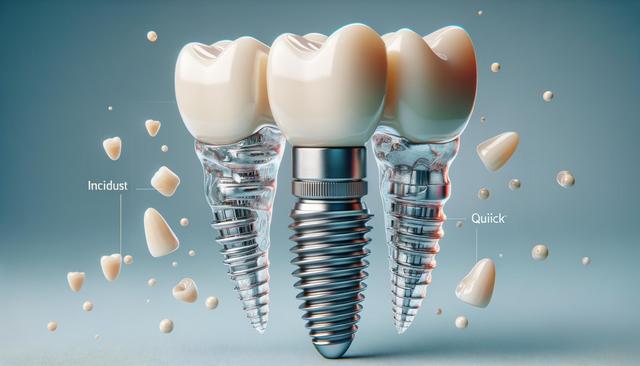What Are Quick Implants?
Quick implants, often referred to as immediate or same-day implants, are a type of dental restoration designed to replace missing teeth in a significantly shorter time frame compared to traditional methods. Unlike conventional implants, which can take several months due to healing and integration phases, quick implants allow for the placement of a temporary or even permanent crown on the same day as the implant surgery. This approach is made possible through advancements in digital imaging, implant materials, and surgical techniques.
The process typically involves fewer appointments and reduced waiting times. Patients who are suitable candidates can walk out with a restored smile on the same day. However, this method is not ideal for everyone and requires a thorough assessment by a dental professional to determine bone density, gum health, and other factors that impact success rates.
Quick implants are particularly beneficial for individuals who have lost teeth due to injury or decay and want a prompt solution without compromising functionality or aesthetics. While the term “quick” suggests speed, the planning phase remains crucial to ensure precision and long-term stability.
How the Procedure Works
The quick implant process begins with a detailed consultation and diagnostic imaging, such as 3D scans, to evaluate the patient’s oral structure. This step helps the dentist plan the exact positioning of the implant, ensuring optimal results. Once the planning is complete, the procedure typically follows these steps:
- Tooth extraction (if necessary)
- Implant placement into the jawbone
- Attachment of a temporary crown or restoration
One of the key differences between quick implants and traditional implants is the lack of a prolonged healing phase before the crown placement. In traditional methods, the implant is left to integrate with the bone over a period of three to six months before the crown is added. With quick implants, the crown is placed immediately or within a few days, depending on the case.
Despite the faster treatment time, the technology used ensures that the implant is securely anchored and functions like a natural tooth. Modern materials and techniques have significantly increased the success rate of immediate implants, making them a reliable option for many patients.
Who Is a Candidate for Quick Implants?
Not everyone is a suitable candidate for quick implants. Several criteria must be met to ensure the procedure’s success and longevity. Candidates generally need to have:
- Good overall oral health
- Sufficient bone density in the jaw
- No active gum disease or infection
- Non-smokers or willingness to quit smoking
Patients with chronic health conditions like diabetes or those undergoing treatments that affect bone healing may face additional considerations. A comprehensive evaluation by a dental implant specialist is essential to determine candidacy.
In some cases, preparatory procedures such as bone grafting or gum treatment may be required before the quick implant process can begin. These steps help to create a stable environment for the implant, increasing the likelihood of successful integration and long-term function.
Benefits and Drawbacks of Quick Implants
Quick implants offer several advantages, particularly for those who value time and convenience. Some of the key benefits include:
- Faster restoration of function and appearance
- Fewer dental visits and shorter treatment timeline
- Immediate confidence boost from restored aesthetics
- Reduced need for temporary dentures or bridges
However, there are also potential drawbacks to consider. Because the procedure bypasses the traditional healing phase, there may be a slightly higher risk of implant failure if aftercare instructions are not followed closely. Patients must maintain excellent oral hygiene and attend follow-up visits to monitor the implant’s stability.
Cost can also be a consideration, as quick implants may involve advanced imaging and materials that add to the overall expense. Nevertheless, for many patients, the convenience and immediate results can justify the investment.
Post-Procedure Care and Long-Term Outcomes
After receiving quick implants, proper aftercare plays a vital role in ensuring their success. Patients are typically advised to:
- Follow a soft food diet during the initial healing phase
- Avoid smoking and alcohol consumption
- Maintain optimal oral hygiene with gentle brushing and flossing
- Attend regular dental checkups
While quick implants are designed for immediate function, they still require time to fully integrate with the bone. This process, known as osseointegration, continues in the background and is crucial for long-term stability. Most patients experience strong, lasting results when they adhere to the recommended care guidelines.
Long-term success also depends on factors like bite alignment, jaw health, and lifestyle choices. Dental professionals may recommend periodic imaging to assess the implant’s condition over time and detect any early signs of complications. With consistent care, quick implants can function effectively for many years, offering both comfort and confidence in daily activities.
Conclusion: Is a Quick Implant Right for You?
Quick implants can be a valuable solution for those seeking a faster and efficient way to restore their smile. While not suitable for everyone, they offer clear advantages in convenience and appearance when performed on eligible candidates. If you’re considering this option, consult with a qualified dental professional to assess your suitability and explore a personalized treatment approach. With the right preparation and care, quick implants can provide a seamless blend of speed and reliability in dental restoration.






